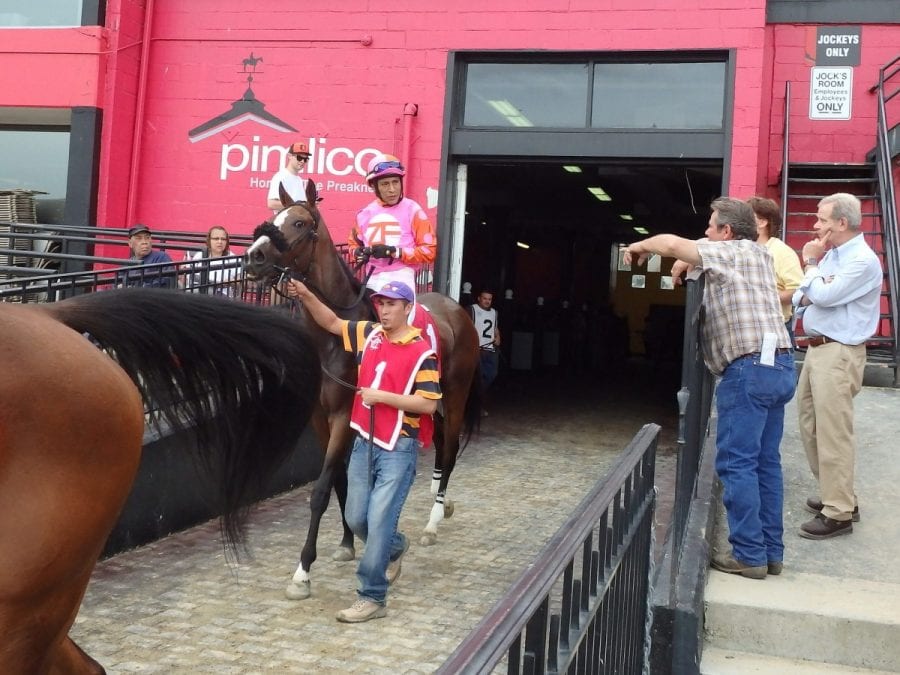Pimlico: City, Stronach Group announce agreement, but much work remains

The Preakness will be a much smaller and more exclusive event, but it will remain at its historic home in northwest Baltimore if plans announced today come to fruition.
The plans are the result of several months of negotiations among the Stronach Group/Maryland Jockey Club, the City of Baltimore, and the state’s Thoroughbred horsemen.
The groups said in a joint letter to Gov. Larry Hogan (R), state Senate President Mike Miller (D-Prince George’s), and House Speaker Del. Adrienne Jones (D-Baltimore County) that they “came together with a newfound spirit of cooperation and purpose to explore possible ways and means to preserve the Preakness Stakes at Pimlico, to support year-round sustainable racing at Laurel Park and to facilitate community development in and around the racing facilities.”
The letter was co-signed by Baltimore Mayor Jack Young; Stronach Group Chairman and President Belinda Stronach; Baltimore County Executive John Olszewski, Jr.; Anne Arundel County Executive Steuart Pittman; and the three men who primarily negotiated the deal, Williah H. Cole, reprsenting the city; Alan Rifkin, counsel to the Maryland Jockey Club; and Alan Foreman, who is general counsel to the Maryland Thoroughbred Horsemen’s Association.
The result of those efforts is a nearly-$400 million plan that would see an upscale, scaled-down Pimlico remain the home of the Preakness while becoming more closely woven into the surrounding communities, with Laurel Park becoming the year-round racing and training home for the state’s Thoroughbred industry.
“[T]his plan will establish Maryland as the epicenter of thoroughbred racing in the United States and enhance Maryland’s growing breeding industry,” said Alan M. Foreman, who represented the Maryland thoroughbred industry, in a release.
The plan will require action by the state Legislature. The 2020 legislative session begins in January.
According to the proposal, the Stronach Group would “contribute the entire Pimlico site to the CIty or an entity established by the city.” That new entity would be charged with managing a more-than-100 acre property that, it is envisioned, would include multiple parcels earmarked for development, the racetrack and associated facilities, and fields and other facilities for community use.
All existing racetrack infrastructure would be demolished, and the track itself would be rotated so that the first turn would abut Winner Avenue and the far turn would abut Pimlico Road. Currently, the track more nearly abuts Northern Parkway on one side and Belvidere Ave. on the other. The rotation would open the site to more development.
The new Pimlico would cease to be used for training. Instead, it would have only a handful of stables available for in-today. horses.
The frontside centerpiece of the new Old Hilltop would be a combination clubhouse and multi-purpose events center usable by the community during the year when racing is not taking place.
That clubhouse will have seating for 3,500 for the Preakness, according to the concept development plan.
While the current Pimlico includes extensive permanent seating — nearly 15,000 capacity in the clubhouse, new grandstand, old grandstand, and dining areas — the new Pimlico will rely largely on temporary seating to fill out its footprint.
The front side will include, in addition to the clubhouse itself, an additional 12,000 reserved temporary seats along the track apron. Also on the front, along the first turn, will be an enclosed lounge with seating for 1,500.
In the infield, atop landscape berms, will be temporary suites and track view dining. Also in the infield will be a picnic lawn and a general admission area. All told, the plan envisions the new Pimlico having a capacity of about 51,500.
What has driven the plan forward was a 2019 legislative session that, for the city and racing industry, turned into a debacle. The Stronach Group put its weight behind legislation that would have turbo-charged its efforts to turn Laurel into what the company has called a “super track” and would have revitalized the Bowie Training Center.
The city, meanwhile, sought legislation to create a group to study how to fund a new Pimlico based on plans crafted by the Maryland Stadium Authority.
Neither plan went anywhere, and last-minute machinations gained nothing while helping to spike legislation the Maryland State Fair had sought to allow the Timonium Race Course to participate in ongoing Racetrack Facilities Renewal Funds (RFRA).
The good news, however, came later, as outreach from Mayor Bernard “Jack” Young to Stronach Group Chairman and President Belinda Stronach led the sides back to the negotiating table.
“This is an historic moment,” Mayor Young said in a statement. “The Preakness Stakes is an important part of the City’s legacy and future… I could not be any more pleased, excited or proud.”
The plan also envisions a significantly redesigned Laurel Park. While the historic paddock would remain in place, it would no longer be the paddock, which instead would be moved into the middle of a new, two-pronged clubhouse. Most of the existing barns would be removed, as well, with a series of new barns bringing total capacity to 1,584 stalls. And the track would add additional, improved backstretch housing.
Also new would be the track configuration. While Laurel Park currently has a 95-foot wide dirt course and a turf course that spans 142 feet in width, configurable into six different lanes, the new Laurel would have three different surfaces: a 70-foot wide dirt track, a 100-foot wide turf course, and in between, a 70-foot wide Tapeta surface, the last of which could be used for training and for days that come off the turf.
“These are transformative plans for the racing industry in Maryland and will benefit all of the stakeholders in the industry and the communities that surround the facilities,” Belinda Stronach agreed.
But lurking behind the good will is the reality that these plans are contingent on legislative action, which is by no means guaranteed.
The combined plans are estimated to cost $375,500,000, with about $200 million of that total dedicated to the Pimlico project.
The plan proposes that the state-chartered Maryland Stadium Authority issue $348 million in bonds to support the project. The debt service on those bonds, $17 million annually, would be paid with a variety of funds: $5 million annually that the horsemen would contribute from the purse account, $3.5 million from Baltimore City, and $8.5 million from the Racetrack Facilities Renewal Account (RFRA).
RFRA — a fund created by with a portion of the state’s slot machine revenue — is supposed to begin winding down in 2026 and to expire by 2032. But the new Pimlico plan envisions RFRA being available for the 30 year debt service period.
That would require the Legislature to act, and it’s unlikely that the state’s casino industry will be eager to continue to subsidize the racing industry more than it needs to. Additionally, the state is facing a budget deficit at a time when it is supposed to be ramping up its education spending to meet the goals of the so-called Kirwan Commission.
So the plans announced today represent progress, but there’s still a long way to go before a Preakness takes place at a redesigned Pimlico.
Or, as Rifkin put it, “This is a first step, but an important one.”
LATEST BUSINESS NEWS
Colonial: Claiming Crown preview set for Aug. 21
Colonial Downs will for the first time host a Claiming Crown Preview day on Aug. 21 featuring eight races run under starter allowance conditions.
Journalism tabbed as Preakness future wager favorite
Journalism, the likely favorite in the Kentucky Derby, is the 8-1 morning line favorite in the Preakness future wager, which opens April 25-May 3.
HISA issues equine health advisory
The Horseracing Integrity and Safety Authority (HISA) has issued an equine health advisory regarding fatal proximal forelimb fractures.
Laurel: “Preakness Preview Day” handle robust
Laurel’s “Preakness Preview Day” wagering handle was nearly double its best day of 2025 to date.
Charles Town to race April 23
After losing most of two cards to weather last weekend, Charles Town Races will run an additional night of live racing April 23.
MTHA endorses change to claiming price rule
The Maryland Thoroughbred Horsemen’s Association (MTHA) on Wednesday endorsed a less restrictive claiming rule than currently in place.















Thanks for reporting.